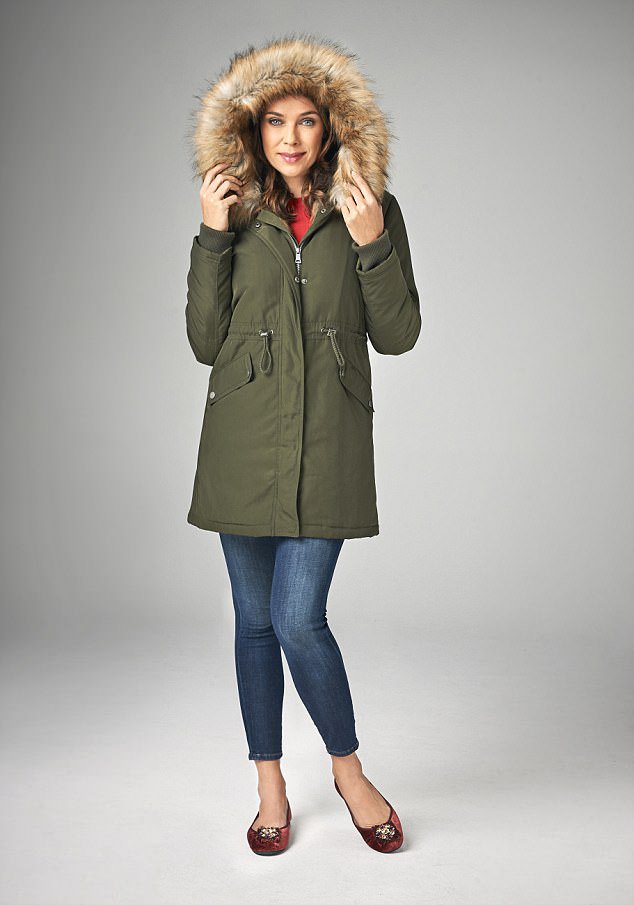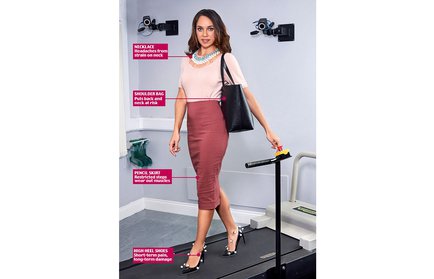From pencil skirts that strain muscles to jeans that cause arthritic knees
- According to the British Chiropractic Association, many clothes cause muscular pain, and have a long-term effect on posture, blood flow and our backs
- To find out exactly what damage is being done, FEMAIL asked Ron McCulloch at the London Podiatry Centre to conduct the most up-to-date scientific tests
- It seems even the smallest fashion item could cause long-term problems. Read on and you may want to leave your statement necklace in the jewellery box...
Surely it’s enough to make even the most dedicated follower of fashion wince.
According to new research by the British Chiropractic Association, many of the day-to-day clothes from pencil skirts to skinny jeans and large furry hoods can cause muscular pain, and have a long-term effect on posture, blood flow and our backs. Even statement necklaces, it appears, should come with a health warning.
So to find out exactly what damage is being done, we asked consultant podiatric surgeon Ron McCulloch at the London Podiatry Centre to conduct the most up-to-date scientific tests.
He observed a model wearing clothes which experts say could cause back pain — then analysed her gait and posture with the latest high-tech equipment, giving his informed opinion of how it was twisting her figure out of place.
First, Ron used motion capture technology, called Vicon 3D, to assess how the model walked naturally, then how she walked in each item.
Small sensors were attached to her pelvis, knees and feet. Then an infrared camera filmed her walking on a treadmill, in a neutral outfit and with the clothing on test. It picked up the motion of the sensors, which translated to a 3D model on a computer, and analysed every potential problem.
Next, Ron employed pressure-mapping technology, known as Tekscan. It looks deceptively simple — you stand for a few seconds on a simple blue mat, but inside it are hundreds of sensors which show weight distribution between your two feet. The ideal is an equal weight distribution of 50 per cent on each foot.
‘The second element of Tekscan is the sway test. This shows how stable you are,’ says Ron. ‘Using the same pressure technology, it demonstrates how much the body wobbles.’ If you’re out of balance, your spine can be pulled or twisted, leading to back pain.
In our tests, we used the sway test on our model to analyse how far heavy bags or clothing can make you swing from side to side.
Finally, after putting our model through her paces, Ron analysed the results. Worryingly, they revealed that the dangers of wearing certain clothing day-in-day-out may be more dramatic than first thought.
It seems even the smallest fashion item could cause long-term problems. Read on and you may want to leave your statement necklace in the jewellery box . . .
HEAVY NECKLACE HEADACHE
These may be fashionable, but the weight can pull the neck forward and cause pain.
We put our model in a 300g necklace and placed her on the pressure mapping mat to measure how her weight was distributed between her left and right side.
‘The necklace had altered her stance,’ says Ron. ‘She naturally stands with 40 per cent of her weight on the left foot and 60 per cent in the right, and it changed to 37 per cent on the left and 63 per cent on the right, so she was standing slightly more unevenly, possibly to compensate for the weight of the necklace. Even if the neck is pulled forward just a little, the posture is altered slightly.’
This, he says, can contribute to neck discomfort and headaches, caused by tilting your neck forwards or from tensing the muscles at the back of the neck to support the extra weight of the necklace.
In the long-term you may suffer persistent headaches, neck strain and severe backache, poor balance and aching shoulders.
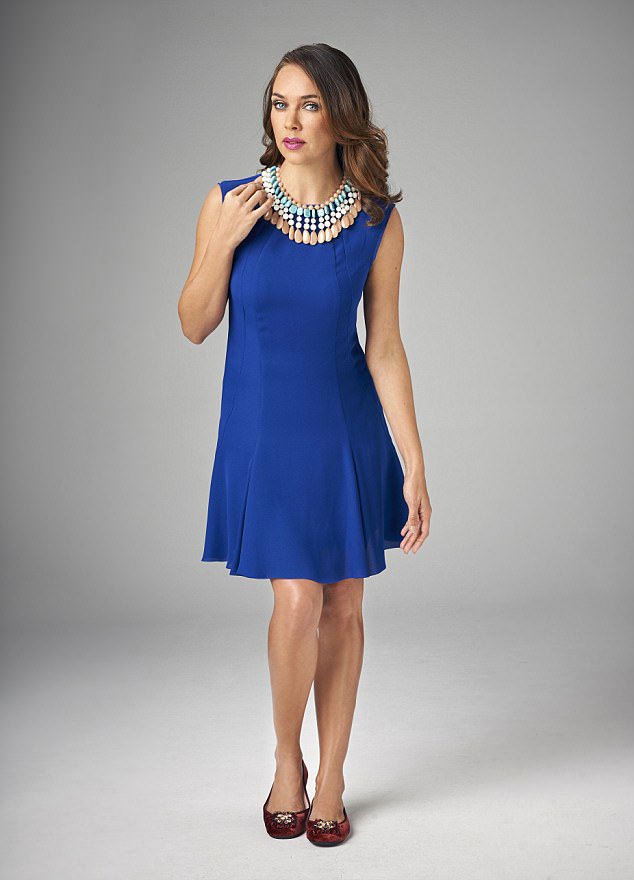
SKINNY JEANS AND KNEE PAIN
It seems these tight jeans can have a significant impact on knees, digestion and even blood circulation, as our analysis revealed. ‘Our 3D assessment showed that when the model walked in skinny jeans, the knees didn’t extend correctly, their movement was reduced by around 15 per cent, so the model’s walking was restricted,’ says Ron.
Unless clothing stretches to move with your body, this may eventually cause joint pain, and with skinny jeans, that’s likely to be concentrated around knees. ‘Even pressure on a knee cap may irritate the knee joint,’ explains Ron.
And this can exacerbate arthritis and cartilage wear-and-tear.
Problems aren’t limited to your knees. ‘Tight clothing can affect circulation,’ Ron adds. ‘Although arteries, which move blood away from the heart, aren’t likely to be affected, the veins, which push blood back to the heart for reoxygenation, may struggle more.’
This could cause swelling of ankles and associated problems such as pressure on nerves and tissues. And a tight waistband can make digestion more sluggish — increasing the symptoms of bloating.
Skinny jeans can even be life threatening. In 2015 a woman was reported to have almost died from the effects.
As a result of the tight fabric restricting her blood flow, her calves were so swollen that the muscle tissue was dying.
However, Ron says: ‘That was a rare extreme.’
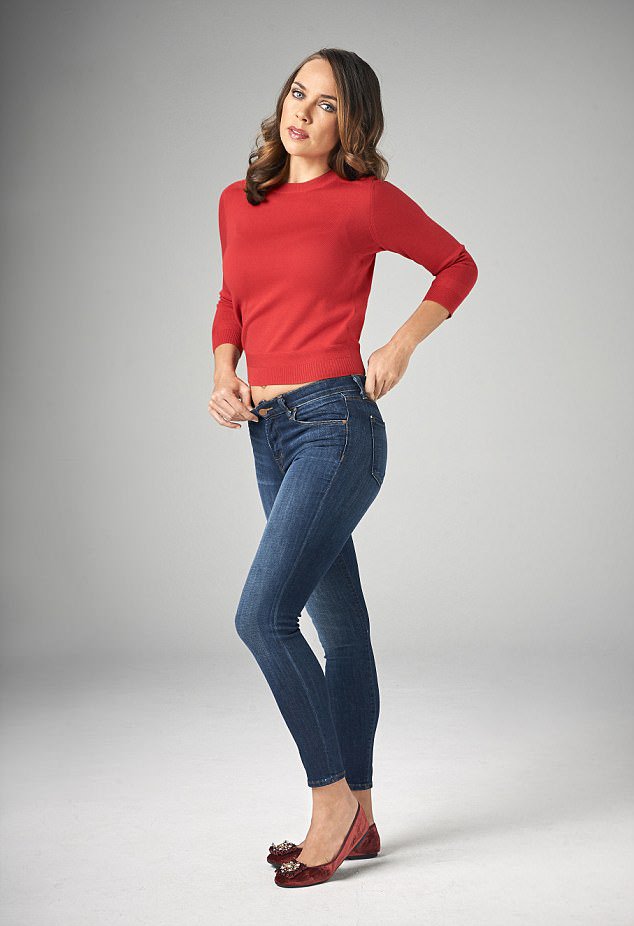
THE HANDICAP OF A BULKY BAG
As you walk, you naturally sway slightly from side to side.
But if you’re carrying something heavy this sway can be increase, sending your posture out of kilter — and putting your back and neck at risk.
‘We’d say the ideal sway from side to side is below 30cm,’ says Ron. ‘If you had a serious neurological disorder [which would lead to a loss of balance] it might measure well over 100cm.’
When our model was analysed without a bag, her measured sway was just 25cm.
However, with a tote weighing just under 11 lb over her shoulder, her sway increased to 45cm, ‘a significant difference’ says Ron, with potentially painful implications.
That heavy bag altered her previously good gait, and so then it put everything from her shoulders to her toes in an uncomfortable position.
Indeed, the 3D scan showed the model raised her right shoulder to try to compensate for the weight.
‘She naturally has one leg very slightly longer than the other, which is quite common, as well as very slightly increased collapsed arch on her left foot,’ says Ron.
‘As she walked, we could see that the forward and backwards movements of the hips weren’t balanced and the arch in her left foot became more collapsed.
‘When we viewed her balance in bare feet, she began in her natural position of 40 per cent of her weight on the left foot and 60 per cent in the right.
‘Add a handbag, and she shifts to 67 per cent on the right foot, imbalancing her body even further.’ This could have several long-term impacts.
‘There’s a risk of shoulder and neck pain,’ says Ron. ‘And a risk of trapping a nerve, radiating pain into the arms or causing carpal tunnel syndrome [which causes pain, tingling and a numbness in the hand and fingers] thanks to the strain on muscles.’
And as the spine isn’t being held straight, there’s a high chance of back pain and even arthritis.
![bag]](/media/images/3F30798C00000578-4405982-image-a-5_14920298633.width-800.jpg)
IT’S HELL IN HIGH HEELS
Our model stands well in 5in high court shoes and her postural sway is fine which Ron attributes to her youth and general good health. But her toes were pushed down into the point of the shoe. And they were pushed even more when we tested her in backless mules, which have no support around the heel and ankle.
Short-term, this can cause pain. But long-term, it can mean bunions, calluses and problems with the Achilles tendon which runs down the calf muscle to the heel.
‘I see many elderly ladies who’ve worn heels for years and now have permanently shortened calf muscles. When they wear flat shoes, their feet collapse at the arch, and, of course, heels increase the risk of falling over no matter what your age.’
It’s worrying to note that our 30-year-old model already had tight calf muscles and during the sway test actually stood more comfortably in heels than flat shoes, so accustomed has her body become to wearing heels.
‘We specialise in a very common cause of forefoot pain, Morton’s neuroma, where a trapped nerve in the foot causes intense pain,’ says Ron, who is one of only two clinicians in the UK to offer cryosurgery to treat the condition. ‘Some 80 per cent of the patients who are treated for the condition are women.
‘I have no doubt that the cause is woman’s footwear.’

WALKING SHORT IN A PENCIL SKIRT
It’s perhaps the definition of classic sexiness: a long tight pencil skirt, with a tantalising slit in the back. However, it could cause damage to your leg muscles, warns Ron.
‘The 3D scanning shows that stride length — how far you can extend the legs forward — is restricted by 10 to 15 per cent when wearing a pencil skirt, so the model has to take smaller steps,’ he explains.
And while this isn’t likely to cause any immediate problem — apart from the fact that you might be late for work — Ron points out that in extreme cases it may become subject to what is known as Davis’s Law.
‘This is where, over time, your body’s soft tissue adapts to the environment. Eventually — and I have to say that we are talking about wearing a pencil skirt every day for six months here — your muscles would not be able to stretch properly.
‘When fashions change, and skirts become shorter or looser, you’ll be in discomfort as legs will revert to their natural stride,’ explains Ron.
He advises not wearing restrictive skirts all the time or it could lead to muscle problems akin to repetitive strain injury.
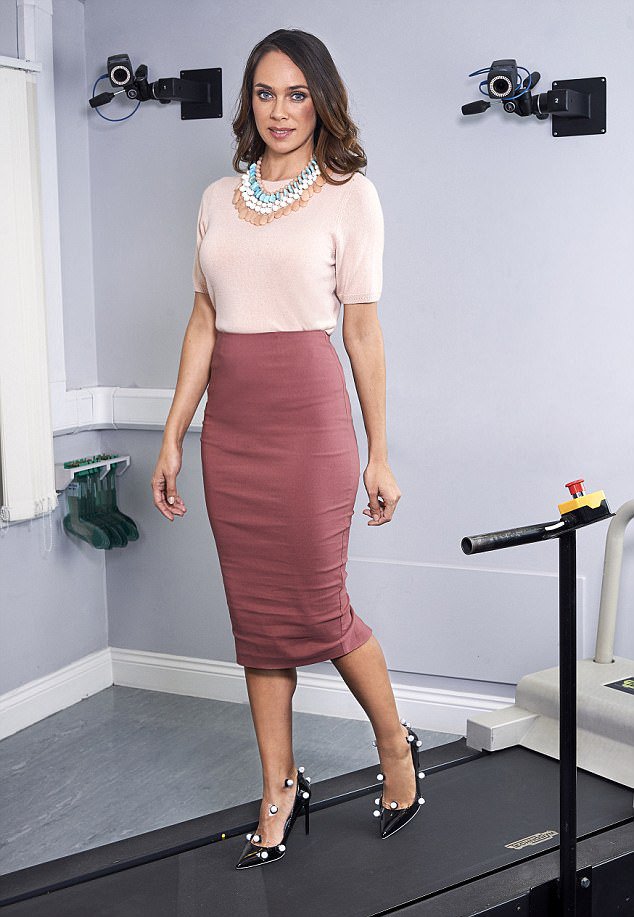
THE HEADACHE OF LARGE HOODS
‘It’s clear the neck is forced to extend in order to see out of the hood,’ says Ron. Although the infrared camera which measured the movement of the lower half of the model’s body did not reveal any problems with gait, the postural change had potential to cause pain, he warned.
‘If you are leaning forwards constantly you are using additional muscles at the back of the neck in an unnatural fashion. Over time this may cause fatigue, tension, neck and shoulder pain and even tension headaches.’
Long term it will have all the same problems as the heavy necklace — including backaches.
